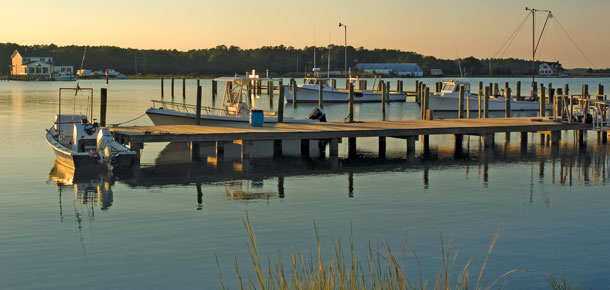Knauss legislative fellowships in Congress help build careers — and they're fun and educational. See our video and fact sheet for details.
Bay Culture

“Wonder lies in the Bay and its watershed in full measure.”
– Tom Horton, Bay Country
The Chesapeake Bay is more than a body of water, more than America’s largest estuary. For those who live near its shores, the Bay provides a powerful sense of local identity.
In the warm months, it is a home for workboats stacked with pots or equipped with coiled trotlines looking to catch blue crabs. Swimmers and recreational boaters enjoy relaxed days exploring the Bay’s waters and creating memories. In the colder months, the Bay even welcomes a few skipjacks whose crews still hoist their sails in pursuit of oysters as they have for generations.
For Marylanders, these cultural traditions offer ways of knowing the Bay that are as important as what science teaches us about it. Different people view the Bay through different lenses. Maryland Sea Grant has worked to fund and publish scholarly research by social scientists about these different ways of seeing and knowing. The scientists’ findings offer to inform public discussions and consensus-building about how best to restore the Bay.
Some examples of social science we’ve supported:
- Michael Paolisso of the University of Maryland, College Park has argued that public discussions about Bay restoration often neglect to consider watermen, farmers, and others as "environmentalists." This means that conservation advocates may fail to take full advantage of these groups’ strong ethic for preserving both the soil and the Bay. Read more in Paolisso’s book, Chesapeake Environmentalism: Rethinking Culture to Strengthen Restoration and Resource Management, part of the Chesapeake Perspectives series published by Maryland Sea Grant. For sale through our Bookstore.
- Erve Chambers, also at the University of Maryland, College Park has questioned the often-expressed view that Bay cultures are "dying." According to Chambers, a characteristic that most defines the iconic Eastern Shore watermen is their resilience, their capacity to make do. Read more in Heritage Matters: Heritage, Culture, History, and Chesapeake Bay, also in the Chesapeake Perspectives series. For sale through our Bookstore.
Maryland Sea Grant also published Working the Chesapeake: Watermen On the Bay, a book describing in words and pictures the lives and work of the watermen who fish for oysters, blue crabs, finfish, soft and hard clams, and eels. For sale through our Bookstore. Sadly it’s a depiction of a disappearing world.
The sense of place that Marylanders draw from the Chesapeake is also reflected in the robust body of art and literature about it. Photographers and painters have depicted the beauty of its landscape. Writers have transformed the Bay into a rich character, weaving it through plots and storylines.
The Chesapeake has served as a backdrop for key moments in our nation's history, including the Revolutionary War and the War of 1812. An estuary that opens to the sea, the Bay provided an important, consequential highway between the Old and New Worlds in America’s early days — and today.
Our webpage on Coastal Planning and Land Use describes efforts by Maryland Sea Grant Extension staff to help communities in the Chesapeake region plan for the future, through land-use policies and other means. The goal is to preserve the region's natural resources and the businesses and jobs that depend on them.
Maryland Sea Grant Extension has produced economic analyses of the value of recreational boating in Maryland.



